NVIDIA Shield Review: At the Crossroads of PC and Mobile Gaming
by Brian Klug on July 31, 2013 12:14 AM ESTGPU Performance - 3DMark
The GPU performance story is finally a competitive one for NVIDIA. Although Tegra 4 lacks full OpenGL ES 3.0 compliance, it does finally dedicate enough SoC die area to GPU performance to compete with the likes of Apple and the iPad with Retina Display. We'll start with 3DMark, which is Android and Windows only at this point.
3DMark for Android features the Ice Storm benchmark and uses OpenGL ES 2.0. Ice Storm is divided into two graphics tests and a physics test. The first graphics test is geometry heavy while the second test is more pixel shader intensive. The physics test, as you might guess, is CPU bound and multithreaded. The overall score takes into account both graphics and physics tests. The benchmark is rendered to an offscreen buffer at 720p/1080p and then scaled up to the native resolution of the device being tested. This is a very similar approach we've seen by game developers to avoid rendering at native resolution on some of the ultra high resolution tablets. The beauty of 3DMark's approach here is the fact that all results are comparable, regardless of a device's native resolution. The downside is we don't get a good idea of how some of the ultra high resolution tablets would behave with these workloads running at their native (> 1080p) resolutions.
Here we see Tegra 4 in Shield outperforming all of the shipping players on Android, and virtually tying with Adreno 330 in Qualcomm's upcoming MSM8974 (Snapdragon 800 platform). Tegra 4's GPU performance is still no where near even Intel's HD 4000, but we're seeing massive improvements in raw FP throughput in ultra mobile GPUs. I'm very eager to see what's possible once Kepler makes its way into NVIDIA's mobile SoCs next year with Logan.
The 3DMark Physics test is also worth looking at as it shows a 36% increase in performance over four Krait 300 cores running at 1.5GHz. There are faster Krait 300s out there, but another 13% isn't enough to make up this gap. The Krait 400 comparison is much closer, but the Krait 400s have to be clocked at 2.3GHz to equal the performance of the 1.9GHz Cortex A15s. It remains to be seen which combination is ultimately lower power.
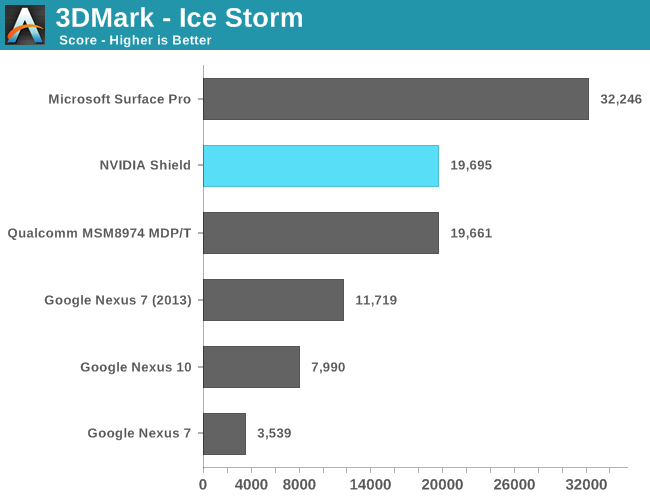
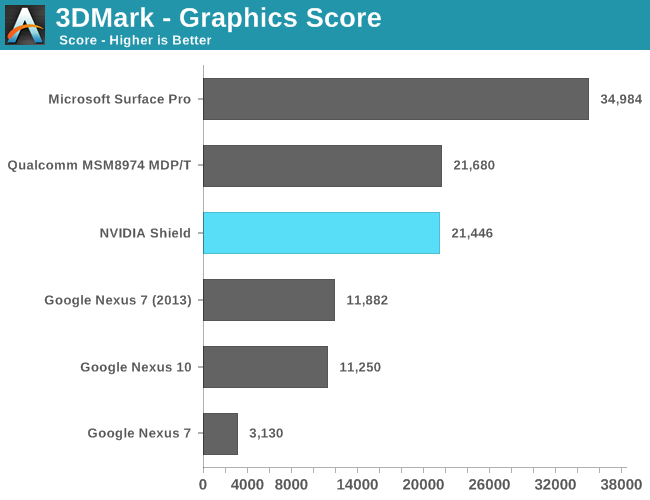
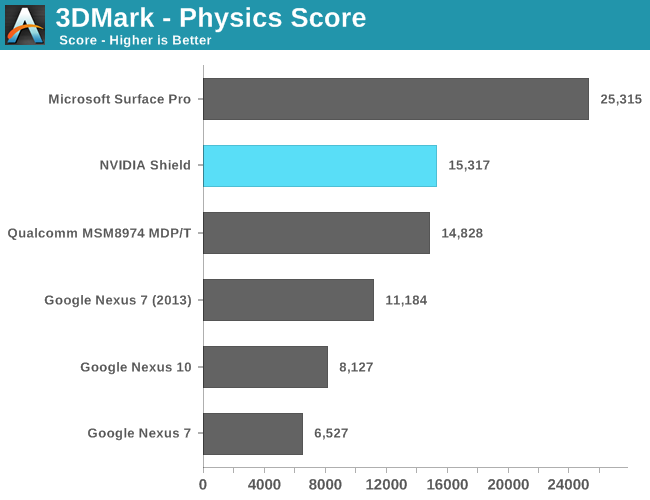

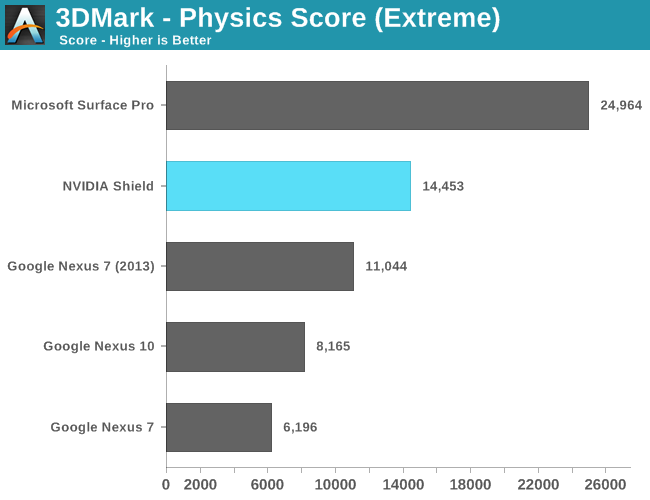
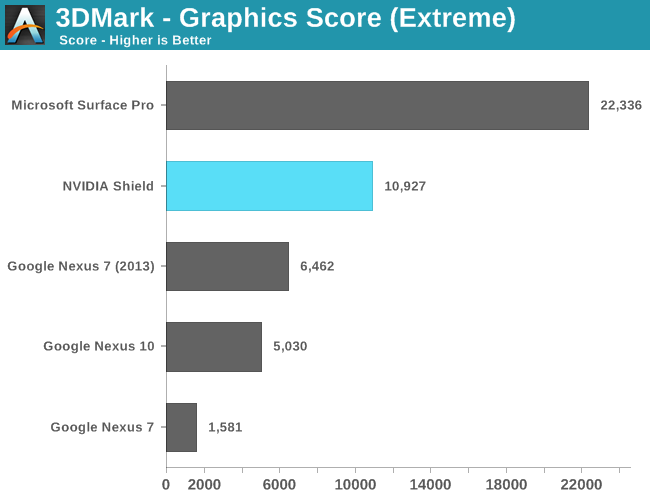
Basemark X
Basemark X is a new addition to our mobile GPU benchmark suite. There are no low level tests here, just some game simulation tests run at both onscreen (device resolution) and offscreen (1080p, no vsync) settings. The scene complexity is far closer to GLBenchmark 2.7 than the new 3DMark Ice Storm benchmark, so frame rates are pretty low.
In both tests, NVIDIA posts big gains over anything presently shipping from the Android camp. Adreno 330 pulls ahead on a level playing field, holding a 24% performance advantage over Tegra 4.
I would've loved to have seen this sort of competition from NVIDIA back when the iPad 4 launched, but it's at least good to see NVIDIA move from being a value player with Tegra 3 to a high performance contender with Tegra 4.
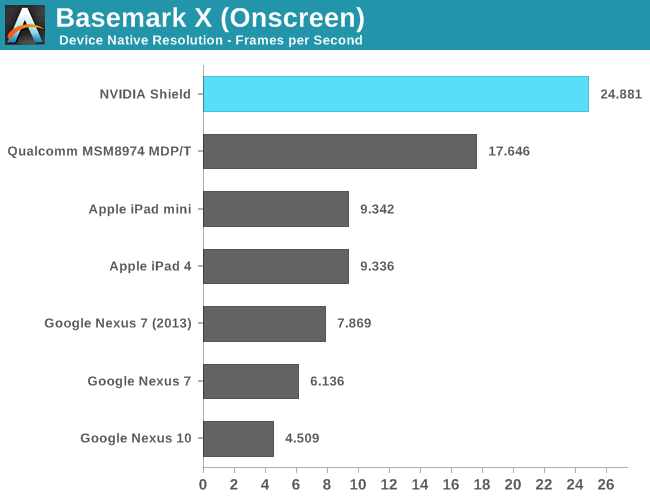
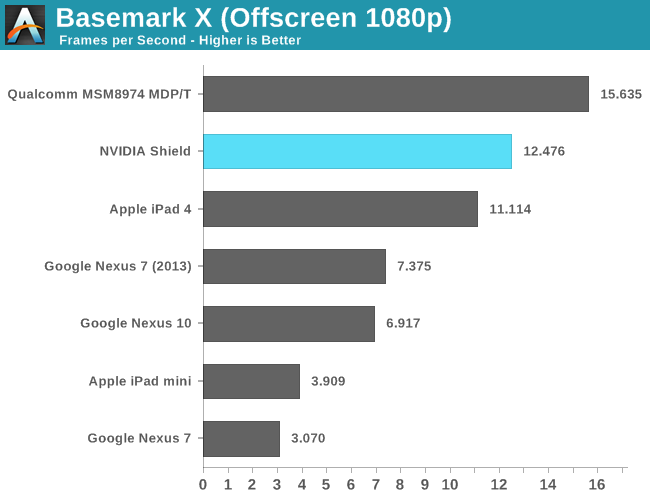










134 Comments
View All Comments
Revdarian - Wednesday, July 31, 2013 - link
I am sorry but you really felt comfortable with a "mobile" gaming device that weight over half a kilo for how long?How comfortable/uncomfortable was it reported by anyone else who actually tried it for prolonged time?
Brian Klug - Wednesday, July 31, 2013 - link
Because it spreads a lot of its area out, it really isn't that bad. I definitely spent at least two hours playing nonstop Borderlands 2 without thinking about it. And lots of time outdoors with the AR Drone 2.0.-Brian
zebrax2 - Wednesday, July 31, 2013 - link
For a gaming device review i find it a little disappointing that it seems like not a lot of time was spent playing with the devicejasonelmore - Friday, August 2, 2013 - link
He's been playing With shield for over three months including all of these expos him and anand have went to. I think it's safe to say he's had more playtime than any other reviewer.blanarahul - Wednesday, July 31, 2013 - link
I too want a Nvidia designed phone.chizow - Wednesday, July 31, 2013 - link
Who knows, after Tegra 4i launches, if Shield does well enough, that may be the next step for Nvidia.Samus - Thursday, August 1, 2013 - link
If anything, this great review proves Shield is a technology showcase for Tegra 4, and how excellent it will be in a phone. Obviously active cooling will be nixed so the clocks will drop, but the battery life is substantial.Spunjji - Thursday, August 1, 2013 - link
I don't understand the logic here. The clocks will have to drop so performance will as well. Power will drop as well probably - depends on leakage) but then you'll be dealing with a much, much smaller battery. To be honest it's a massive unknown at best.PC Perv - Wednesday, July 31, 2013 - link
You can't be serious. So now weight is relative to shape, in your hands? And talk about the shape.Unbelievable how far reviews would go to put gloss on stuff that reviewers themselves will never pay for. The ranting at Google in the last page is pure gold. Talk about "entitlement mentality."
chizow - Wednesday, July 31, 2013 - link
Why isn't it serious? How weight is balanced and distributed across a surface plays a HUGE impact in how it feels in the hand. This isn't a foreign concept to just mobile devices, look at how knives, daggers, even guns are critiqued in this respect.